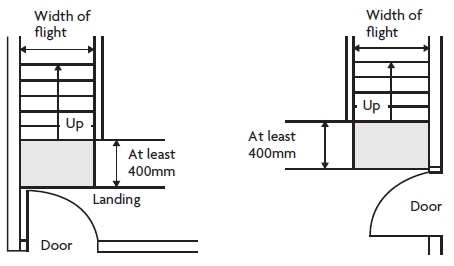Landings in buildings
Landings are level platforms found at the top or bottom of flights of stairs. Intermediate landings may be found part way up flights of stairs where there is an intermediate level, where there is a change in direction of the flight of stairs, or where there is a long flight of stairs.
Approved document K protection from falling, collision and impact, requires that there is a landing at the top and bottom of every flight, with a width and length at least as great as the smallest width of the flight of stairs.
Landings should be clear of permanent obstructions. They may have doors to cupboards or ducts that open over them, but these should remain closed in normal use. Other doors may swing across landings in dwellings, but only as shown below.
A headroom of at least 2m should be provided on all landings.
Where there are more than 36 risers in consecutive flights of stairs, Approved Document K requires that there is at least one change of direction, with a landing that has a minimum length equal to the width of the stairs. Landings in building other than dwellings should be at least 1200mm long.
For buildings other than dwellings, the maximum number of risers should be 16 for utility stairs, and 12 for general access stairs (or 16 in exceptional circumstances where the plan area is restricted). Landings in buildings other than dwellings should have suitable handrails on each side.
Landings may also be found at the top, bottom and along the length of ramps. They must be at least as long as the width of the ramp. For buildings other than dwellings, they must be at least 1200mm long at the top and bottom of the ramp, and at least 1500mm long for intermediate landings.
Approved Document M sets out additional guidance and requires the provision of landings as rest areas for wheelchair users and people with walking difficulties, and to provide space for wheelchair users to stop and open doors.
Approved Document M also refers to landings in front of lifts.
Approved Document B sets our additional requirements in relation to fire safety.
NB see also: Soft landings.
[edit] Related articles on Designing Buildings Wiki
- Ancillary area.
- Approved Document B.
- Approved Document K.
- Approved Document M.
- Banister.
- Building regulations.
- Escalator.
- Finial.
- Flight.
- Guarding.
- Intermediate landing.
- Lifts.
- Lobby.
- Maximum length of a flight of stairs.
- Newel post.
- Railings.
- Ramps.
- Spiral stairs and helical stairs.
- Stairs.
- Stairs going.
- Stairs nosing.
- Stairs riser.
- Stairs string.
- Stairs tread.
- Stairlift.
- Types of stairs.
- Wheelchair platform stairlifts.
Featured articles and news
RTPI leader to become new CIOB Chief Executive Officer
Dr Victoria Hills MRTPI, FICE to take over after Caroline Gumble’s departure.
Social and affordable housing, a long term plan for delivery
The “Delivering a Decade of Renewal for Social and Affordable Housing” strategy sets out future path.
A change to adoptive architecture
Effects of global weather warming on architectural detailing, material choice and human interaction.
The proposed publicly owned and backed subsidiary of Homes England, to facilitate new homes.
How big is the problem and what can we do to mitigate the effects?
Overheating guidance and tools for building designers
A number of cool guides to help with the heat.
The UK's Modern Industrial Strategy: A 10 year plan
Previous consultation criticism, current key elements and general support with some persisting reservations.
Building Safety Regulator reforms
New roles, new staff and a new fast track service pave the way for a single construction regulator.
Architectural Technologist CPDs and Communications
CIAT CPD… and how you can do it!
Cooling centres and cool spaces
Managing extreme heat in cities by directing the public to places for heat stress relief and water sources.
Winter gardens: A brief history and warm variations
Extending the season with glass in different forms and terms.
Restoring Great Yarmouth's Winter Gardens
Transforming one of the least sustainable constructions imaginable.
Construction Skills Mission Board launch sector drive
Newly formed government and industry collaboration set strategy for recruiting an additional 100,000 construction workers a year.
New Architects Code comes into effect in September 2025
ARB Architects Code of Conduct and Practice available with ongoing consultation regarding guidance.
Welsh Skills Body (Medr) launches ambitious plan
The new skills body brings together funding and regulation of tertiary education and research for the devolved nation.
Paul Gandy FCIOB announced as next CIOB President
Former Tilbury Douglas CEO takes helm.
UK Infrastructure: A 10 Year Strategy. In brief with reactions
With the National Infrastructure and Service Transformation Authority (NISTA).























